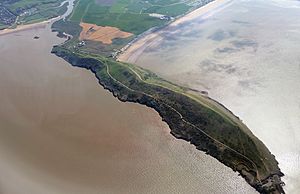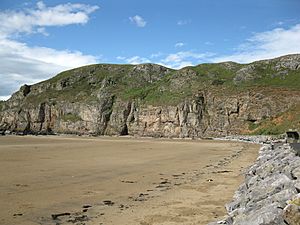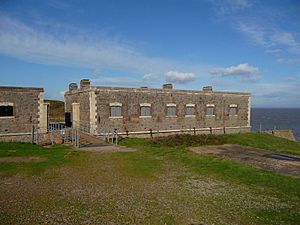Brean Down facts for kids
Quick facts for kids Brean Down |
|
|---|---|
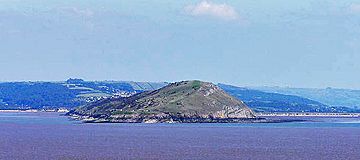
Brean Down from Steep Holm
|
|
| Highest point | |
| Elevation | 97 m (318 ft) |
| Prominence | 91 m (299 ft) |
| Geography | |
| Location | Mendip Hills, England |
| OS grid | ST284590 |
| Topo map | OS Landranger 182 |
Brean Down is a cool, long hill that sticks out into the sea in Somerset, England. It's about 97 meters (318 feet) tall and stretches 2.4 kilometers (1.5 miles) into the Bristol Channel. You can find it between the towns of Weston-super-Mare and Burnham-on-Sea.
This hill is made of a type of rock called Carboniferous Limestone. It's like an extension of the Mendip Hills. Even further out in the sea, the small islands of Steep Holm and Flat Holm are also made of this rock. The cliffs of Brean Down are full of fossils from sea creatures that lived 320–350 million years ago!
People have lived here since the late Bronze Age. You can still see parts of an old Romano-Celtic Temple. At the very end of Brean Down, there's Brean Down Fort. It was built in 1865 and used again during the Second World War.
Today, the National Trust owns Brean Down. It's a special place because of its amazing wildlife, history, and archaeology. It's even called a Site of Special Scientific Interest because of its unique rocks and rare plants, like the white rock-rose. It's also protected as an ancient monument.
Contents
What is Brean Down Made Of?
Brean Down is the most western part of the Mendip Hills. These hills are made of Carboniferous Limestone. This rock formed about 320–350 million years ago. Imagine, a long, long time ago, huge forces pushed the Earth's crust together. This created mountains and hills across Europe, including the Mendips.
Brean Down is over 2 kilometers (1.2 miles) long. It stretches from east to west near the mouth of the River Axe. The top of the hill is flat, about 97 meters (318 feet) above sea level. This flat area might have been a beach when sea levels were much higher!
The cliffs on both sides of Brean Down are full of fossils. You can find corals, seashells, and crinoids (which look like sea lilies). These fossils show that the rocks were formed underwater. Scientists have found 13 different layers of rock in the 'sand cliff' on the south side. The bottom five layers are from the last Ice Age.
A Look Back in Time: Brean Down's History
People have lived on Brean Down for a very long time. We know this from things left behind by the Beaker culture in the late Bronze Age. There are also signs of an Iron Age hill fort and ancient burial mounds called barrows.
There was a special place of worship here even before the Romans arrived. Later, in the mid-4th century, it became a Romano-Celtic Temple. Some people think a small Christian church might have been built there after that. Many Roman items have been found here, like gold and silver coins and a Roman ring.
Brean Down Fort
Brean Down Fort was built between 1864 and 1871. It was part of a chain of forts protecting the Bristol Channel. These forts guarded important cities like Bristol and Cardiff. The fort was built on 4 acres of land at the end of Brean Down.
In the 1860s, there were plans to build a big port on the north side of Brean Down. It was meant to replace Bristol as a major port for ships crossing the Atlantic. But a big storm destroyed the foundations, and the project was stopped.
Wireless and War
In 1897, a famous inventor named Guglielmo Marconi moved his radio equipment to Brean Down. He had just sent wireless messages from Wales. From Brean Down, he set a new record, sending a wireless message 14 kilometers (8.7 miles) over the open sea!
In 1912, the Royal Society for the Protection of Birds rented Brean Down. They wanted to protect the birds living there.
When World War II started, the fort was used again. It was armed with large guns and machine gun posts. Nearby, the famous "Bouncing bomb" was tested at Brean Down Fort.
Brean Down Today
After the war, in 1954, a large part of Brean Down was given to the National Trust. More land was added in 1963 and 2000. In 2002, the fort itself was also given to the Trust after it was restored.
There have been ideas to build a huge wall, called a Severn Barrage, across the Bristol Channel from Brean Down to generate electricity from the tides. These ideas have been around for over 100 years, but so far, none have been built.
Amazing Nature and Wildlife
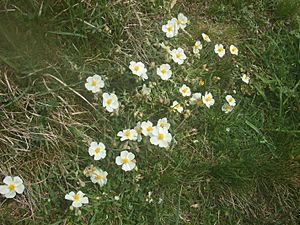
Brean Down is not just important for its rocks, but also for its plants and animals. That's why it's a Site of Special Scientific Interest.
Plants
A rare plant called the white rock-rose grows in large numbers on the sunny, grassy slopes. Other plants you might see include the Somerset hair grass, wild thyme, horseshoe vetch, and birds-foot-trefoil. The northern side of the hill has lots of bracken, bramble, privet, hawthorn, cowslips, and bell heather.
Animals
Many different birds live on Brean Down. You might spot a peregrine falcon, jackdaw, kestrel, or different kinds of doves. Smaller birds like the common whitethroat, common linnet, stonechat, dunnock, and rock pipit are also common. In 2007, a very rare Atlantic yellow-nosed albatross was seen nearby!
Brean Down is also home to several types of butterflies. Look out for the chalkhill blue, dark green fritillary, meadow brown, marbled white, small heath, and common blue.
Images for kids


